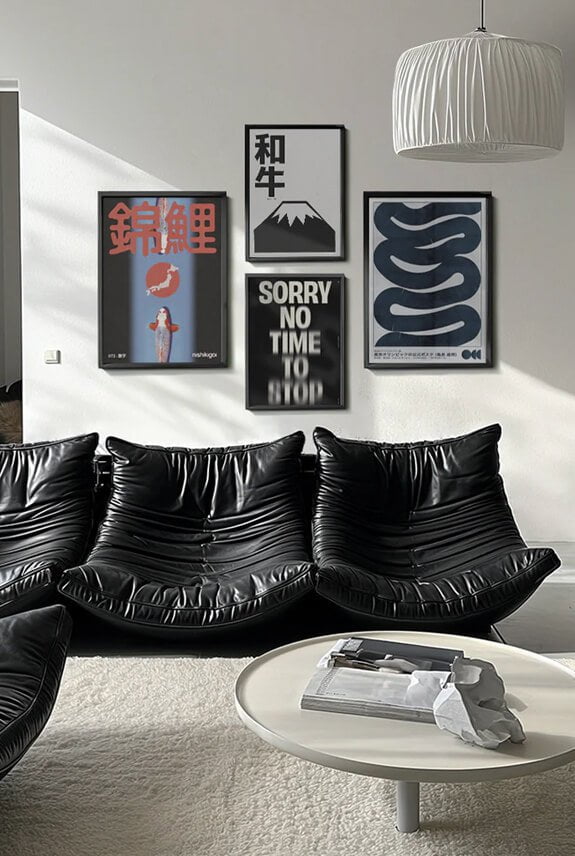The challenges of the global housing crisis have more people than ever before sharing houses. Indeed, not only are we now more likely to have housemates, but we’re also more likely to stay in co-living situations for longer. With median wages tapering off throughout much of the world, we’re also starting to see more homeowners take in boarders or housemates as a way to supplement their incomes.
As you might expect, co-living situations don’t always turn out smoothly, especially in cases where housemates have equal rights to shared spaces. In such situations, common areas in shared houses can easily turn decrepit and ramshackle—and not in a trendy maximalist kind of way.
Regardless, everyone has the right to live in beautiful surroundings. This is exactly why DROOL offers authentic, artist-sanctioned art prints like these illustration art posters at accessible prices. The problem is that your housemate may have a completely different idea about what “beautiful” is. If so, how do you make sure that everyone gets the space they need to express themselves around their home? Let’s explore some strategies for finding common ground in decorating shared spaces:
1) Prioritise Open Communication

Open and honest communication is the only way you can guarantee a pleasant co-living situation. You don’t necessarily need to hold regular house meetings, but you should, at least, have occasional honest chats about your preferences and overall vision for your shared spaces.
2) Establish Shared Values

Once you’ve developed an understanding of your housemates’ preferences, you can start looking for common ground on how to decorate communal areas. If you’re lucky, you might find that everyone has similar tastes and that your wall art is welcome pretty much everywhere. Even if turns out that you don’t have similar tastes you should, at least, develop an appreciation for the limits that you push when decorating.
3) Be Prepared to Compromise

Compromise is key to avoiding conflict in co-living situations. Even if your housemates love your DROOL prints and your overall aesthetic, there’s no guarantee that they will continue to agree with everything else that you do. At the end of everything, maintaining good relationships with the people you live with is still more important than having great-looking interiors.
4) Collectively Designate Personal Area

Talk with your housemates and agree to specific areas within the shared space where individuals have autonomy over the decor. For example, you can agree to which rooms or walls each tenant has exclusive rights to decorate. This way, everyone can express their personal style without encroaching on each others' preferences.
5) Agree to Repaint with Neutral Colours

If you’re splitting a space, it can be difficult to make things look tied together unless there’s a coherent underlying element. If the area is due for a repaint, ask your landlord (if you’re not the homeowner) and fellow housemates if they would be fine doing it up with a neutral colour or wallpaper that works for everyone. This can help make the shared spaces look cohesive even if every wall has a different theme.
6) Invest in Storage

If your landlord and housemates agree to it, high wall-to-wall shelving can be an aesthetically pleasing yet functional solution to clutter. It should give everyone in the house a space to store less-accessed books and trinkets that don’t visually overwhelm the room. This way, you’ll have more space elsewhere to decorate with art prints and other ornaments or decor pieces.
If you have space in your personal areas, you can also invest in a few stackable boxes that are large enough to store most of your possessions. This extra storage should afford you some leeway to switch up your art illustrations now and then. As a bonus, having these boxes on hand will make moving out much easier.
7) Don’t Overstep Your Boundaries

Home decor is probably not going to be a priority for all your housemates. If the other people in your house seem disinterested in decorating or cleaning up, it can be tempting to put up an art poster on “their side” or do other things beyond what you agreed to. You probably don’t want to do this since it can lead to tension and resentment. Always consult your housemates if you want to make changes that impinge on their personal spaces.
8) Engage in DIY Projects and Collaborations

Engage in collaborative DIY projects that will allow you and your housemates to contribute to the decor together. Whether it's choosing illustration art posters, setting up Christmas decorations, or upcycling furniture, shared creative endeavours can nurture real friendships as well as a shared sense of ownership over the space.
9) Respect Your Housemates

While it’s true that decorating is about personal expression, you should also be sensitive to the preferences of the other people you share your home with. After all, a home that is superficially beautiful but puts you and your housemates on edge is not a pleasant one to live in. Fortunately, if you prioritise harmony and remain sensitive to everyone else’s needs, you will create beautiful environments, regardless of what happens.
10) Compromise Is an Art

There is no magic solution for decorating common areas. In all cases, comes down to empathy, communication, and a willingness to compromise. You might not always get what you want, but that’s OK. The goal of home decorating isn’t just to create beautiful spaces or to show off your wall art but also to create positive relationships and a shared sense of belonging. By keeping sight of what’s important, you can turn your shared living situation into a harmonious and enjoyable experience for all.




































































































































